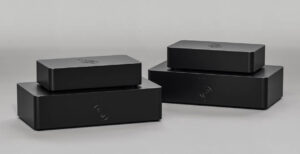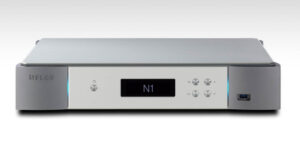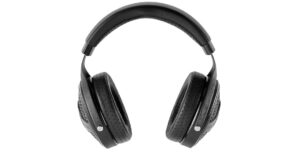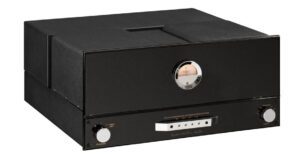
At the start of the decade, Audio Research announced a strictly limited two-box line preamplifier to celebrate 40 years of the brand. The Reference Anniversary model was only available during 2010, but it became the cornerstone of a lot of subsequent technologies introduced by Audio Research. However, in making those subsequent preamplifiers, Audio Research has learned a lot, and that has filtered back into the Reference 10 line preamplifier.
The Reference 10 models – a matching two-box phono stage is also available – stand apart from the rest of the range. They are effectively beyond the flagship of the Audio Research range and move into a new realm; the mainframe preamplifier.
In fact, it’s not a new idea for Audio Research at all, it’s just been lying dormant for a while. Traditionally, the company built its flagship designs in twin chassis – most notably the classic SP10 from the 1980s – but even in that vaunted company, the Reference 10 is big. Power-amp dwarfing big.
One of the two large chassis houses the source connections, display, and logic circuitry; the other is the power supply. They are connected by thick Burndy multi-pin cables of the type used by Naim Audio for its top-end devices. These are thick, inflexible, and designed to carry power from device to device with the maximum amount of internal screening, so there is no possibilty of one power supply feed interacting with the others.

That control box is comprehensively supplied, with seven line inputs (technically six and a processor), all running XLR balanced or RCA single-ended. There are three similarly specified outputs, one of which is also destined for processor use. The Reference 10 is also heavily logic controlled, from the timed 40-second standby in power-up to the assignable input names on the large green front panel touch display, everything is driven by the on-board logic circuits. However, using touch screen control does mean the volume control knob has a genuine 104-step attenuator sitting behind it.
Allocating most of the Reference 10’s control surfaces to a touchscreen does result in a very minimalist front panel, with just the aforementioned volume control, hard buttons for power and mute and an eye for the remote control. However, this positively bristles with more gadgets than a 1960s spy movie compared to the front panel of the power supply box, which has a LED and nothing more.

There are a lot of valves in this preamplifier. More than most valve pre-power combinations, in fact. The eight 6H30P double-triode tubes in the line and gain stages are joined by two 6H30P and two 6550C valves in the power supply. That’s more or less like having a small mono power amplifier with valve rectification being used to drive a preamplifier. In preamp terms, that’s overkill’s big brother.
Stylistically, the Reference 10 is in something of an odd place, straddling the product design of ARC preamps of old, without the aesthetic of the latest Foundation and Reference line, and being something of an outlier. Not that anyone who is going to invest in the Reference 10 will care at all; this is all about the sound and the performance, not how it looks on the rack. Given each box is larger and heavier than most preamps, and cost more than twice the price of their Audio Research Reference siblings, the Reference 10 (both line and phono) having their own style is probably no bad thing.

The Reference 10 is not for everyone – the price itself is a self-sealing function of that even before anything else is taken into account. But perhaps even more importantly, the Reference 10 is only really a viable option for those willing to push the limits of what can be resolved in an audio system. As a result, it’s the kind of device that demands an absolutist approach to system design; the phrase ‘we’ll wing it’ is alien and meaningless to the Reference 10. Even shortening the name ‘Reference 10’ to ‘Ref 10’ seems wrong here… it would have been like referring to Gregory Peck as ‘Greg’; it’s just not done. Put a foot wrong anywhere in the system and the Reference 10 will point it out. A track where the recording or mastering engineer didn’t bring their A-game to the party is given the same uncompromising stare. Here’s the degree of observation required; some systems will suit the Reference 10 with power supply below the control box, others will require the two boxes sitting side-by-side… and will demand the same attention to detail in other links in the chain. For my part, separating control and power supply on their own respective ‘brains’ and ‘brawn’ stacks didn’t make as much musical sense as one atop the other on their own shelves. Your mileage may vary. Perhaps that is the reason for the design; if it were Audio Research’s ‘bling’ super preamplifier, there would be those with very deep pockets who would buy it for its looks and status. Consciously and actively making the Reference 10 look so completely businesslike means those drawn to a ‘mug’s eyeful’ will leave the Reference 10 to the enthusiasts. The kind of people who know when to use and not to use balanced. And the Reference 10 is the place for balanced operation.
Granted, every XLR source input on the Reference 10 has an accompanying single-ended RCA pair of terminals, and the logic isn’t fussy which inputs you use. The Reference 10 is so forthright in its performance, where balanced is an option you will spend about a semiquaver of music in making up your mind to go balanced throughout. It’s not that the Reference 10 has better balanced than single-ended inputs; instead, it shows up that many single-ended outputs represent a ‘good enough’ approach. That ‘good enough’ stance might be perfectly fine in a great system, but the Reference 10 merely starts the clock at ‘great’. It’s what comes after ‘great’ that impresses you about the Reference 10 .
When placed in as uncompromised a system as you can muster, the Reference 10 opens up a musical world that remains out of reach for most. This is authoritative without being authoritarian, nimble without being lightweight, stentorian without being overblown, dynamic without being intense, detailed without being etched, and so on. Tonally, it just sounds ‘right’. A good preamp (and they are rare) either gets out of the way of the music, or makes a good sound that makes that ‘getting out of the way’ part less important.
This isn’t just about hearing more from your recordings, although that is what first attracts you to the Reference 10’s performance. It’s like a reset button on your music. Tracks you know so well aren’t just replayed as if it were the first time you heard them; they are rebuilt note-by-note in front of you, opening up that music in ways you can’t anticipate until you experience them. Yes this is about detail, space, and dynamic range – Bernard Purdie’s drum pedal on ‘Memphis Soul Stew’ [KIng Curtis Live at Filmore West, ATCO] has a squeak that really high-resolution systems can resolve. Many of those are brutally analytical rendering the track hard to hear because of that ever-present squeak, but the Reference 10 forces you beyond that, to a point where it is just a part of the musical whole again. It’s just this time, there are so many more parts to that whole. Let’s put it this way; anyone who was actually at that concert almost 50 years ago might have heard that squeaky drum pedal, and I guarantee not one person walked out of the concert because of that squeak. That’s how the Reference 10 pushes ahead of the competition. That’s not to say the preamplifier is forgiving, but instead is so informative that detail alone isn’t enough; it’s like you get a new set of ears with the Reference 10 and they take everything in! Going back to more real world preamps is an exercise in disappointment.

What you learn from the Audio Research Reference 10 preamp is just how deep ‘good enough’ goes, and just how much more you can get from a system if you set ‘good enough’ aside. What you also learn from the preamplifier is that is as much about the listener as it is the system, or even the music played on that system. Many will be content with simply having a system that sounds excellent, but if even that degree of insight is not enough and if you are up for the challenge laid down by the Reference 10 preamplifier, the rewards are remarkable.
TECHNICAL SPECIFICATIONS
- Type: Two box line preamplifier
- Inputs (7): 1, 2, 3, 4, 5, 6, PROCESSOR. (XLR and RCA connectors)
- Outputs (3): 2 main, 1 tape (XLR and RCA connectors)
- Frequency Response: +0 -3dB 0.1Hz to 200kHz at rated output. (BALANCED, 200k ohms load.)
- Distortion: Less than .006% at 2V RMS Balanced output
- Gain: Main output (SE or BAL input): 12dB Balanced output, 6dB Single Ended output. Tape output: 0dB. (Processor input: 0dB Balanced)
- Input Impedance: 120K ohms Balanced, 60K ohms SE
- Output Impedance: 600 ohms Balanced, 300 ohms SE main (2), 20K ohms minimum load and 2000pF maximum capacitance
- Output Polarity: Non inverting
- Maximum Input: 20V RMS maximum Balanced,
(10V RMS SE) - Rated Outputs: 2V RMS (1V RMS SE) into 200K ohm balanced load (maximum balanced output capability is 30V RMS at less than 0.5% THD at 1kHz)
- Crosstalk: -80dB or better at 1kHz
- Controls: Volume (104 steps). Push Buttons: Power, Mute, Interactive Touch Panel. Rear RS-232 control and IR input
- Power Supplies: Electronically regulated low and high voltage supplies. Automatic 40 sec. warm-up/brown-out mute
- Line regulation: better than .01%
- Noise: 1.7uV RMS residual IHF weighted balanced equivalent input noise with volume at 1 (109dB below 2V RMS output.)
- Tube Complement: (8) 6H30P dual triodes, plus (2 each) 6550C and 6H30P in power supply
- Dimensions W×H×D, per chassis: 48 × 17.8×39.4cm, Handles extend 3.8 cm forward of the front panels
- Weight: Audio Chassis: 13.25kg
Power Supply Chassis: 17.88kg - Price: £31,998
Manufactured by: Audio Research
URL: audioresearch.com
Distributed in the UK by: Absolute Sounds
URL: absolutesounds.com
Tel: +44(0)208 971 3909
Tags: FEATURED
By Alan Sircom
More articles from this authorRead Next From Review
See all
Reiki Audio SuperSwitch Master Pro + Servant Pro
- Mar 27, 2024

Melco Audio N1-S38 music server
- Mar 27, 2024

Focal Utopia 2022 headphones
- Mar 27, 2024











